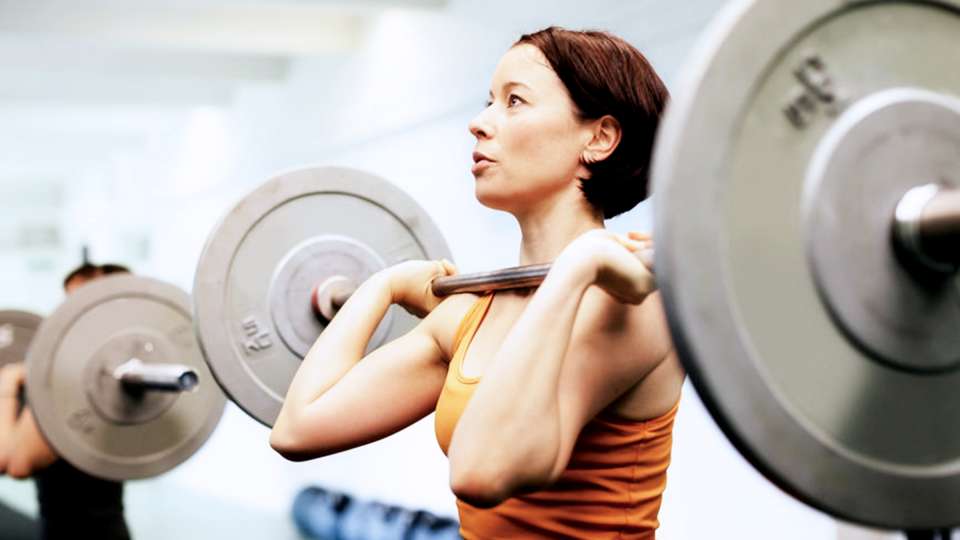
Deadlift, clean and jerk, snatch, press … uh, say what now?
To the uninitiated, the weightlifting world is a pretty intimidating place. The lingo is perplexing, the equipment is daunting and you have no idea where to start.
Sure, you can just stick to your tried-and-true elliptical workout, but you’ll be missing out on a slew of health benefits that weightlifting provides.
“Strength and resistance training can help combat loss of muscle mass, it can help decrease the risk of heart disease by lowering body fat, it can improve your blood pressure and cholesterol, and it can improve your balance and overall strength,” explains Justin Rothmier, M.D., a physician at The Sports Medicine Clinic at Northwest Outpatient Medical Center. “All of those together are ways strength training can improve your quality of life.”
According to national guidelines, you should do some sort of muscle-strengthening activity at least two days each week. That’s in addition to the recommended 150 minutes of moderate-intensity aerobic exercise you need.
So if you’re ready to level up your swole status, here’s how you can safely start lifting weights with the best of them.
Get to know the equipment
Don’t be the person who picks up a barbell for the first time and tries to wing it. (Trust us — that’s just asking for a trip to urgent care.) It’s important to understand your equipment and know how to use it properly before you even attempt your first rep.
When it comes to weightlifting, specifically, there are two main types of equipment: machine weights and free weights.
Machine weights are found in most standard gyms and essentially look like big pieces of padded furniture. Each machine is designed for a certain type of movement to work a specific muscle group.
Free weights, on the other hand, are objects that you can pick up and go. Think dumbbells, barbells and kettlebells. They offer more flexibility in the types of exercises you can do with them but also have a higher risk of injury.
What’s best for beginners? It’s all about what’s most comfortable and available to you, Rothmier says.
Machine weights are a good option because they have instructions and built-in safety features — no barbell dropping on your toe here. Plus, you can usually ask your gym’s staff for a quick demo or equipment walkthrough if you’re not sure how to use something.
But if you’re not able to shell out for a gym membership, free weights may be the way to go. They’re relatively affordable, and you can easily incorporate them into your home workout routine.
“If you’re a beginner who has the initial goals of trying to improve strength, endurance and general fitness, you can achieve all of that whether you use free weights or machines,” Rothmier says.
Warm up and stretch properly
Raise your hand if you start your workouts by stretching for all of 10 seconds and then calling it good.
Yeah, not the best idea, especially when it comes to weightlifting, Rothmier says.
“It’s always a good idea to get warm first,” he explains. “Most of us were taught to do passive stretches, where you hold a stretch, but we’ve found that dynamic stretching, where the muscle is moving and stretching at the same time, can be better.”
Dynamic stretches are movements like arm circles, side lunges and leg swings that work and loosen up your muscles. Even hopping on a stationary bike or going for a quick jog can do the trick.
Once you’re properly warmed up, your muscles are better equipped to tackle that strength training session and less likely to seize up on you mid-set.
What about after your workout? Here’s where those static stretches come into play.
“Your muscles are already warm, so performing static stretching at the conclusion of an exercise program is a great way to improve flexibility,” Rothmier says.
Learn the proper technique
OK, so you’ve familiarized yourself with the equipment and you’ve actually stretched for once. What’s up next?
“Technique, technique, technique,” Rothmier says.
Having proper form when you lift weights is crucial, not only because you need to make sure you’re working the right muscles but also because you don’t want to inadvertently injure yourself.
“With weightlifting, it’s common to sustain injuries as a result of chronic insufficiencies or imbalances,” Rothmier explains. “This is when the technique is wrong, and we see that you’re not balanced in your strength.”
If you’re performing a weightlifting move with bad form, for example, you may not necessarily feel any pain at first. But you’ll eventually develop an injury as you repeat the incorrect technique more frequently and with a heavier weight.
Research proper form — there are countless online videos, Rothmier notes — and seek real-time feedback when possible.
You can also sign up for a session with a personal trainer to learn the basics or even buddy up with an experienced weightlifter, who may be able to quickly identify an issue with your technique.
Start low and go slow
Once you’ve got the proper technique down, it may be tempting to jump in and pump as much iron as your biceps can take.
Yet another not-so-good idea.
“When you overdo it, there’s concern for something called rhabdomyolysis, or rhabdo for short,” Rothmier explains. “It’s a destructive process of muscle tissue and can lead to swelling of the muscles and, when it’s severe enough, even kidney problems.”
Rothmier says beginners and those who are out of practice should start by lifting only two days a week, making sure there’s at least one rest day in-between.
Begin with a low weight (trial-and-error testing is your friend here) and a manageable number of repetitions. Even if you feel like you can do more, it’s best to wait and see how sore you feel the next day.
A good rule of thumb, Rothmier says, is to start with just one set of eight to 12 reps per movement. Then increase the weight and number of repetitions by 2 to 10 percent each week, depending on how your body is feeling.
For example, if you’re able to do a set of eight bicep curls one week using 10-pound dumbbells, try bumping that up to nine reps using 11-pound weights the following week.
You can eventually figure out your happy medium, whether that’s lifting a set weight just to maintain your physical fitness levels or increasing that weight slowly to build muscle.
“Start with the ability to do one complete set, set a reasonable goal and slowly increase from there,” Rothmier says.
Build a well-rounded routine
Once you have your technique down and can comfortably perform a few different movements, it’s time to build a weightlifting program that works for you.
While you may have specific goals, like toning or strengthening a certain area, the most important thing to keep in mind is that you need to have balance in your workouts.
“If you train your chest one day, then you want to do your back and your triceps another day,” Rothmier explains. “You want to train opposite muscles and balance things out to really create a program that’s going to be successful.”
As you get more experienced, you can alternate sets of upper- and lower-body exercises so you’re able to complete a full-body workout all in one gym sesh.
So who’s ready to lift?

 Healthy ideas for your inbox
Healthy ideas for your inbox





